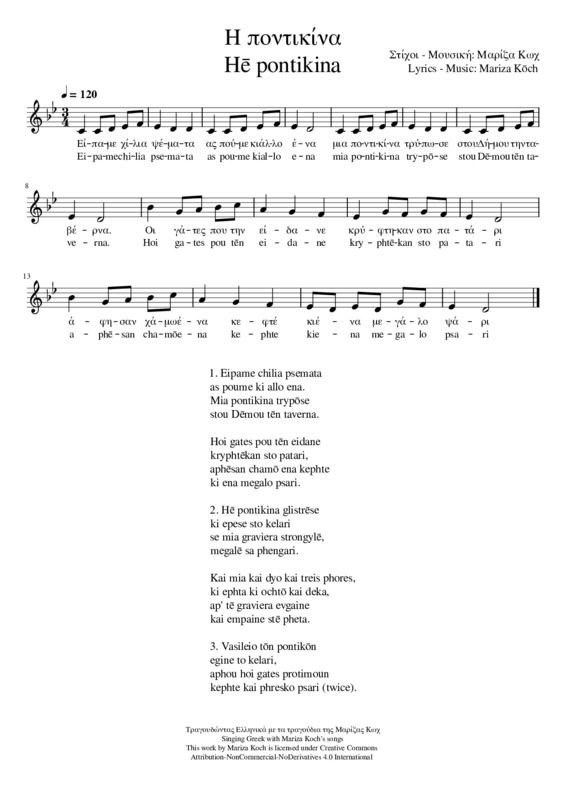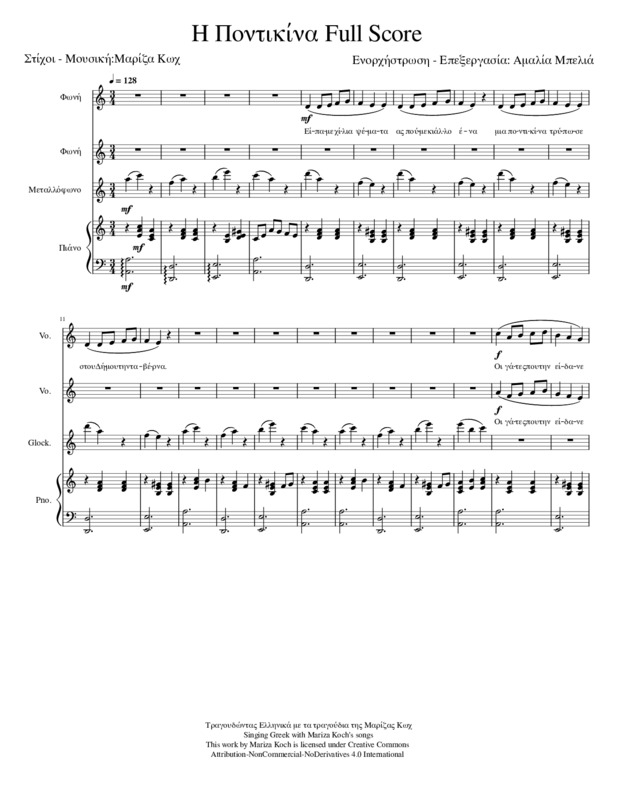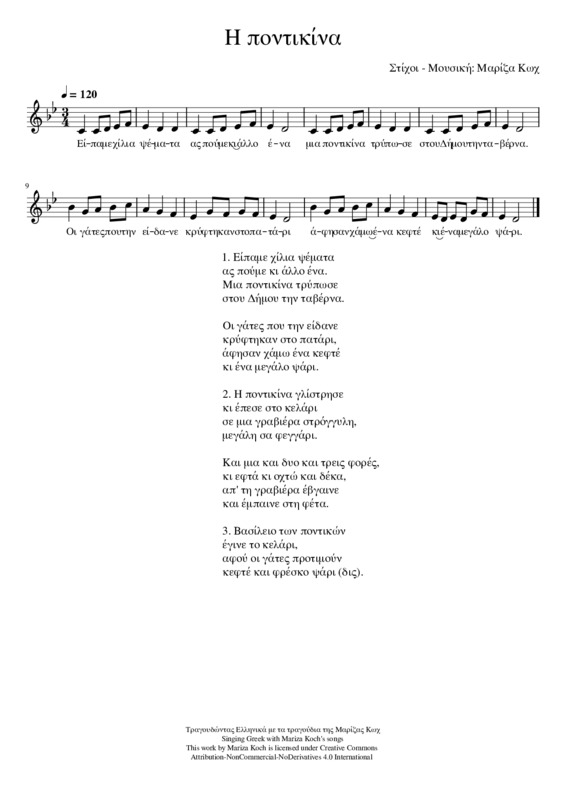
Hē pontikina

Hē pontikina
Pronunciation
Work on the correct pronunciation of the phonemes / γ / (g) and / χ / (ch) in the words of the song [γάτα (gata, cat), γραβιέρα (graviera, gruyere), μεγάλο (megalo, big), χίλια (chilia, thousand), χάμω (chamō, under), οχτώ (ochtō, eight)].
Speech Comprehension and Production
Narrate the story of the song in prose.
What happens in the “ταβέρνα” (taverna, restaurant) of Dimos? Where does the mouse of the song fall? What did he do where he fell? What did the cats do then?
Pupils put an end to the story of the song (group work or the whole class).
Find opposite meanings in the song (mouse-cat, coming in-out, up and down, hiding-revealing, big-small, lie-truth) and create new opposite meanings.
Listen or sing “Στου Μανώλη την ταβέρνα” (stou Manōlē tēn taverna) and identify similarities and differences.
Practice the numeral adjective on the occasion of those mentioned in the song (one, two, three, seven, eight, ten, thousand).
What happens in the “ταβέρνα” (taverna, restaurant) of Dimos? Where does the mouse of the song fall? What did he do where he fell? What did the cats do then?
Pupils put an end to the story of the song (group work or the whole class).
Find opposite meanings in the song (mouse-cat, coming in-out, up and down, hiding-revealing, big-small, lie-truth) and create new opposite meanings.
Listen or sing “Στου Μανώλη την ταβέρνα” (stou Manōlē tēn taverna) and identify similarities and differences.
Practice the numeral adjective on the occasion of those mentioned in the song (one, two, three, seven, eight, ten, thousand).
Music Activities
Practice the rhythmic patterns “τα-τίτι-τίτι” (ta-titi-titi), and “τα-τα-τα” (ta-ta-ta) and accompany the song using these rhythmic patterns by clapping or on percussion instruments.
Divide the class into two groups and perform the song couplets in turn ( first group: the first couplet, second group: the second couplet, etc.).
Create a choreography consisting of funny movements.
Dramatize the song using objects from the classroom environment.
Accompany the song with bordun (IV-V-I-V, C-, D-, G-, D).
Divide the class into two groups and perform the song couplets in turn ( first group: the first couplet, second group: the second couplet, etc.).
Create a choreography consisting of funny movements.
Dramatize the song using objects from the classroom environment.
Accompany the song with bordun (IV-V-I-V, C-, D-, G-, D).
Cross-thematic Connections - Greek Culture
Interdisciplinary concepts: culture, nutrition.
Processed and unprocessed foods. Diet differences between winter and summer. Traditional methods of food preservation and cooking in Greek households of older generations (cellar instead of fridge, built-in oven instead of electric stove, well instead of tap and sink, lantern instead of fridge and cupboards, wood stove instead of electric stove).
Refer to the home economics of the traditional Greek household through visual material and traditional fairy tales [(“Η Δεκαοχτούρα” (hē dekaochtoura), ”Ο Σιμιγδαλένιος” (o simigdalenios) etc.].
Refer to proverbs related to diet: “Φάτε μάτια ψάρια” (phate matia psaria, eyes on, hands off), “Όπου ακούς πολλά κεράσια, κράτα μικρό καλάθι” (opou akous polla kerasia, krata mikro kalathi, promises, promises), “Δύο καρπούζια δε χωράνε στην ίδια μασχάλη” (dyo karpouzia de xōrane stēn idia maschalē, it is impossible to do two things at once), “Το μήλο πέφτει κάτω από τη μηλιά” (to mēlo pephtei katō apo tē mēlia, the apple doesn’t fall far from the tree), etc.
Processed and unprocessed foods. Diet differences between winter and summer. Traditional methods of food preservation and cooking in Greek households of older generations (cellar instead of fridge, built-in oven instead of electric stove, well instead of tap and sink, lantern instead of fridge and cupboards, wood stove instead of electric stove).
Refer to the home economics of the traditional Greek household through visual material and traditional fairy tales [(“Η Δεκαοχτούρα” (hē dekaochtoura), ”Ο Σιμιγδαλένιος” (o simigdalenios) etc.].
Refer to proverbs related to diet: “Φάτε μάτια ψάρια” (phate matia psaria, eyes on, hands off), “Όπου ακούς πολλά κεράσια, κράτα μικρό καλάθι” (opou akous polla kerasia, krata mikro kalathi, promises, promises), “Δύο καρπούζια δε χωράνε στην ίδια μασχάλη” (dyo karpouzia de xōrane stēn idia maschalē, it is impossible to do two things at once), “Το μήλο πέφτει κάτω από τη μηλιά” (to mēlo pephtei katō apo tē mēlia, the apple doesn’t fall far from the tree), etc.
Age level
3-7 years old
Language level
Beginner
Intermediate
Nutrition
Animals
Unpublished






